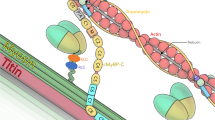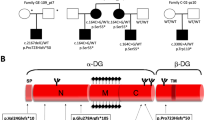Abstract
Brody disease is a rare inherited disorder of skeletal muscle function. Symptoms include exercise-induced impairment of skeletal muscle relaxation, stiffness and cramps. Ca2+ uptake and Ca2+ ATPase activities are reduced in the sarcoplasmic reticulum1–7, leading to the prediction that Brody disease results from defects in the ATP2A1 gene on chromosome 16p12.1–12.2, encoding SERCA1, the fast-twitch skeletal muscle sarcoplasmic reticulum Ca2+ ATPase. A recent search, however, did not reveal any mutations in the ATP2A1 gene in three Brody patients8. We have now associated Brody disease with the autosomal recessive inheritance of three ATP2A1 mutations in two families, suggesting that the disease is genetically heterogeneous. One mutation occurs at the splice donor site of intron 3, while the other two mutations lead to premature stop codons, truncating SERCA1, deleting essential functional domains and raising the intriguing question: how have these Brody patients partially compensated for the functional knockout of a gene product believed to be essential for fast-twitch skeletal muscle relaxation?
This is a preview of subscription content, access via your institution
Access options
Subscribe to this journal
Receive 12 print issues and online access
$209.00 per year
only $17.42 per issue
Buy this article
- Purchase on Springer Link
- Instant access to full article PDF
Prices may be subject to local taxes which are calculated during checkout
Similar content being viewed by others
References
Brody, I.A. Muscle contracture induced by exercise. A syndrome attributable to decreased relaxing factor. New Engl. J. Med. 281, 187–192 (1969).
Karpati, G., Charuk, J., Carpenter, S., Jablecki, C. & Holland, P. Myopathy caused by a deficiency of Ca2+-adenosine triphosphatase in sarcoplasmic reticulum (Brody's disease). Ann. Neurol. 20, 38–49 (1986).
Danon, M.J., Karpati, G., Charuk, J. & Holland, P. Sarcoplasmic reticulum adenosine triphosphatase deficiency with probable autosomal dominant inheritance. Neurology 38, 812–815 (1988).
Taylor, D.J. et al. Ca2+-ATPase deficiency in a patient with an exertional muscle pain syndrome. J. Neurol. Neurosurg. Psychiat. 51, 1425–1433 (1988).
Wevers, R.A. et al. Ischaemic forearm testing in a patient with Ca2+-ATPase deficiency. J. Inher. Metab. Dis. 15, 423–425 (1992).
Poels, P.J.E. et al. Exertional rhabdomyolysis in a patient with calcium adenosine triphosphatase deficiency. J. Neurol. Neurosurg. Psychiat. 56, 823–826 (1993).
Benders, A.A.G.M. et al. Ca2+ homeostasis in Brody's disease. A study in skeletal and cultured muscle cells and the effects of dantrolene and verapamil. J. Clin. Invest. 94, 741–748 (1994).
Zhang, Y. et al. Characterization of cDNA and genomic DNA encoding SERCA1, the Ca2+-ATPase of human fast-twitch skeletal muscle sarcoplasmic reticulum, and its elimination as a candidate gene for Brody disease in three patients. Genomics 30, 415–424 (1995).
MacLennan, D.H. et al. Fast-twitch and slow-twitch/cardiac Ca2+ ATPase genes map to human chromosome 16 and 12. Som. Cell Mol. Genet. 13, 341–346 (1987).
Callen, D.F. et al. Integration of transcript and genetic maps of chromosome 16 at near-1-Mb resolution: demonstration of a “hotspot” for recombination at 16p12. Genomics 29, 503–511, (1995).
MacLennan, D.H., Clarke, D.M., Loo, T.W. & Skerjanc, I. Site-directed mutagenesis of the Ca2+ ATPase of sarcoplasmic reticulum. Acta Physiol. Scand. 146, 141–150 (1992).
Krawczak, M., Reiss, J. & Cooper, D.N. The mutational spectrum of single base-pair substitutions in messenger RNA splice junctions of human genes — causes and consequences. Hum. Genet. 90, 41–54 (1992).
Ebashi, S, Endo, M. & Ohtsuki, I. Control of muscle contraction. Quart. Rev. Biophys. 2, 351–384 (1969).
Brandl, C.J., Green, N.M., Korczak, B. & MacLennan, D.H. Two Ca2+ATPase genes: homologies and mechanistic implication of deduced amino acid sequences. Cell 44, 597–607 (1986).
Wu, K.-D., Lee, W.-F., Wey, J., Bungard, D. & Lytton, J. Localization and quantification of endoplasmic reticulum Ca2+ ATPase isoform transcripts. Am. J. Physiol. 269, C775–C784 (1995).
Carafoli, E., Intracellular calcium homeostasis. Annu. Rev. Biochem. 56, 395–433 (1987).
Lytton, J. & MacLennan, D.H. Molecular cloning of cDNAs from human kidney coding for two alternatively spliced products of the cardiac Ca2+ ATPase gene. J. Biol. Cham. 263, 15024–15031 (1988).
Burk, S.E., Lytton, J., MacLennan, D.H. & Shull, G.E. cDNA cloning, functional expression and mRNA tissue distribution of a third organellar Ca2+ pump. J. Biol. Chem. 264, 18561–18568 (1989).
Berridge, M.J. Capacitative calcium entry. Biochem. J. 312, 1–11 (1995).
Reeders, S.T., Hildebrand, C.E. & Sutherland, G.R. Report of the committee on the genetic constitution of chromosome 16. Cytogenet. Cell Genet. 58, 643–685 (1991).
Thompson, A.D. et al. Isolation and characterization of (AC)n microsatellite genetic markers from human chromosome 16. Genomics 13, 402–408 (1992).
Shen, Y. et al. Dinucleotide repeat polymorphism at the D16S288 locus. Nucl. Acids Res. 19, 5445 (1991).
Breuning, M.H. et al. Two step procedure for early diagnosis of polycystic kidney disease with polymorphic DNA markers on both sides of the gene. J. Med. Genet. 27, 614–617 (1990).
Sambrook, J., Fritsch, E.F. & Maniatis, T. in Molecular Cloning: A Laboratory Manual, 2nd edn. (Cold Spring Harbor Laboratory Press, Cold Spring Harbor, New York, 1989).
Author information
Authors and Affiliations
Corresponding author
Rights and permissions
About this article
Cite this article
Odermatt, A., Taschner, P., Khanna, V. et al. Mutations in the gene–encoding SERCA1, the fast–twitch skeletal muscle sarcoplasmic reticulum Ca2+ ATPase, are associated with Brody disease. Nat Genet 14, 191–194 (1996). https://doi.org/10.1038/ng1096-191
Received:
Accepted:
Issue Date:
DOI: https://doi.org/10.1038/ng1096-191
This article is cited by
-
Targeting oncogenic Notch signaling with SERCA inhibitors
Journal of Hematology & Oncology (2021)
-
Association of 3p27.1 Variants with Whole Body Lean Mass Identified by a Genome-wide Association Study
Scientific Reports (2020)
-
Molecular mechanisms underlying the positive role of treadmill training in locomotor recovery after spinal cord injury
Spinal Cord (2017)
-
The neonatal sarcoplasmic/endoplasmic reticulum calcium ATPase (SERCA1b): a neglected pump in scope
Pflügers Archiv - European Journal of Physiology (2015)



